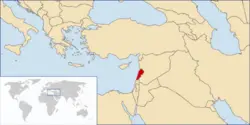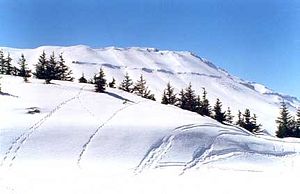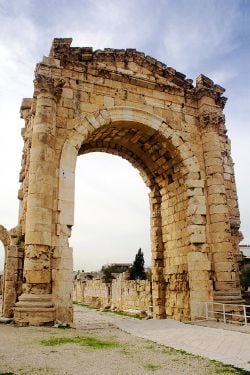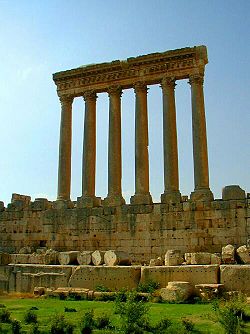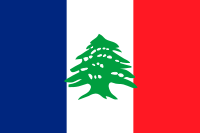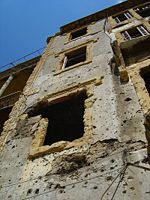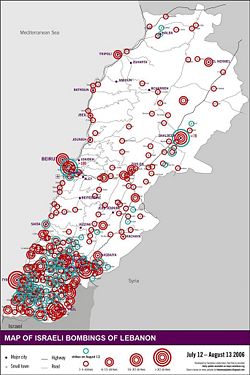Lebanon
| الجمهورية اللبنانية Al-Jumhūriyyah al-Lubnāniyyah Lebanese Republic | |||||
| |||||
| Motto: Kūllūnā li-l-waṭan, li-l-'ula wa-l-'alam (Arabic) "We are all for the Country, the Sublime and the Flag!" | |||||
| Anthem: Kulluna lil-watan lil 'ula lil-'alam | |||||
| Capital | Beirut 33°54′N 35°32′E | ||||
|---|---|---|---|---|---|
| Largest city | capital | ||||
| Official languages | Arabic | ||||
| Government | Republic | ||||
| - President | Émile Lahoud | ||||
| - Prime Minister | Fouad Siniora | ||||
| Independence | |||||
| - Declared | November 26 1941 | ||||
| - Recognized | November 22 1943 | ||||
| Area | |||||
| - Total | 10,452 km² (166th) 4,035 sq mi | ||||
| - Water (%) | 1.6 | ||||
| Population | |||||
| - July 2007 (estimate) estimate | 3,925,502 | ||||
| - Density | 358/km² 948/sq mi | ||||
| GDP (PPP) | 2005 estimate | ||||
| - Total | $24.42 billion | ||||
| - Per capita | 6,681 | ||||
| HDI (2006) | 0.774 (medium) | ||||
| Currency | Lebanese lira (LL) (LBP)
| ||||
| Time zone | EET (UTC+2) | ||||
| - Summer (DST) | EEST (UTC+3) | ||||
| Internet TLD | .lb | ||||
| Calling code | +961 | ||||
Lebanon (Arabic: لبنان Lubnān), officially the Lebanese Republic (Arabic: الجمهورية اللبنانية), is a small, largely mountainous country in the Middle East, located at the eastern edge of the Mediterranean Sea. It is bordered by Syria to the north and east, and Israel to the south. The flag of Lebanon features a cedar in green against a white backdrop, bounded by two horizontal red stripes along the top and bottom. Due to its sectarian diversity, Lebanon follows a special political system, known as confessionalism, meant to distribute power as evenly as possible among different sects.[1]
Until the Lebanese Civil War (1975-1990), the country enjoyed relative calm and prosperity, driven by the tourism, agriculture, and banking sectors of the economy.[2] It was considered the banking capital of the Arab world and was widely known as the "Switzerland of the Middle East"[3][4] due to its financial power. Lebanon also attracted large numbers of tourists,[5] to the point that the capital Beirut became widely referred to as the "Paris of the Middle East."[6]
Immediately following the end of the war, there were extensive efforts to revive the economy and rebuild national infrastructure.[7] By early 2006, a considerable degree of stability had been achieved throughout much of the country, Beirut's reconstruction was almost complete,[8] and an increasing number of foreign tourists were pouring into Lebanon's resorts.[5] However, the 2006 Lebanon War brought mounting civilian and military casualties, extensive damage to civilian infrastructure, and massive population displacement from July 12, 2006 until a ceasefire went into effect on 14 August 2006. As of September 2006, the Lebanese government has been implementing an early recovery plan aimed at reconstructing property destroyed by Israeli attacks in Beirut, Tyre, and other villages in southern Lebanon.
Etymology
The name Lebanon ("Lubnān" in standard Arabic; "Lebnan" or "Lebnèn" in local dialect) is derived from the Semitic root "LBN", which is linked to several closely-related meanings in various languages, such as white and milk.[9] This is regarded as reference to the snow-capped Mount Lebanon.[10] Occurrences of the name have been found in three of the twelve tablets of the Epic of Gilgamesh (2900 bc), the texts of the library of Ebla (2400 bc), and the Bible.[10] The word Lebanon is also mentioned 71 times in the Old Testament.[11][12]
Geography and climate
Lebanon is located in the Middle East. It is bordered by the Mediterranean Sea to the west along a 225 km coastline, by Syria to the east and north, and by Israel to the south. The Lebanon-Syria border stretches for 375 kilometers (233 mi) the Lebanon-Israel border for 79 kilometers (49 mi). The border with the Israeli-occupied Golan Heights in Syria is disputed by Lebanon in a small area called Shebaa Farms, but the border has been demarcated by the United Nations[13] (see Blue Line).
Lebanon has a total area of 10,452 square kilometers (4,036 sq mi), making it the 166th largest country in the world. Most of that area is mountainous terrain,[14] except for the narrow coastline and the Beqaa Valley, an integral part of Lebanon's agriculture.
Lebanon has a moderate Mediterranean climate. In coastal areas, winters are generally cool and rainy whilst summers are hot and humid. In more elevated areas, temperatures usually drop below 0°C (32°F) during the winter with frequent (sometimes heavy) snow; summers, on the other hand, are warm and dry.[15] Although most of Lebanon receives a relatively large amount of rainfall annually (compared to its arid surroundings), certain areas in north-eastern Lebanon receive little rainfall because the high peaks of the western mountain front block much of the rain clouds that originate over the Mediterranean Sea.[16]
In ancient times, Lebanon housed large forests of the Cedars of Lebanon, which now serve as the country's national emblem.[17] However, centuries of trading cedar trees, used by ancient mariners for boats, and the absence of any efforts to replant them have depleted Lebanon's once-flourishing cedar forests.[17]
Administrative divisions
Lebanon is divided into six governorates (mohaafazaat, Arabic: محافظات —singular mohafazah, Arabic: محافظة) which are further subdivided into twenty-five districts (aqdya—singular: qadaa).[18] The districts themselves are also divided into several municipalities, each enclosing a group of cities or villages. The governorates and their respective districts are listed below: Template:Lebanon Labelled Map
| Beirut Governorate
The Beirut Governorate is not divided into districts and is limited to the city of Beirut. |
Nabatiyeh Governorate (Jabal Amel) - 4 districts
|
Beqaa Governorate - 5 districts
|
North Governorate (al-Shamal) - 7 districts
|
Mount Lebanon Governorate (Jabal Lubnan) - 6 districts
|
South Governorate (al-Janoub) - 3 districts
|
Demographics
No official census has been taken since 1932, reflecting the political sensitivity in Lebanon over confessional (i.e. religious) balance.[19] It is estimated that about 40% are Christians (mostly Maronites, Greek Orthodox, Armenian Apostolic, Melkite Greek Catholics, Assyrian Church of the East, Chaldean Catholic), 35% are Shia Muslims, 21% are Sunni Muslims and 5% are Druze.[20] A small minority of Jews live in central Beirut, Byblos, and Bhamdoun. Lebanon has a population of Kurds (also known as Mhallami or Mardinli), of whom are converted Syriacs estimated to be between 75,000 and 100,000 and considered to be part of the Sunni population.[21]
The number of those inhabiting Lebanon proper was estimated at 3,874,050 in July 2006.[20] There are approximately 16 million people of Lebanese descent spread all over the world, Brazil being the country with the biggest Lebanese community abroad.[22] Argentina, Australia, Canada, Colombia, France, Great Britain, Mexico, Venezuela and the USA also have large Lebanese communities.
A total of 394,532 Palestinian refugees have registered in Lebanon with the United Nations Relief and Works Agency (unrwa) since 1948.[23]
Economy
The urban population in Lebanon is noted for its commercial enterprise.[24] Over the course of time, emigration has yielded Lebanese "commercial networks" throughout the world.[25] Lebanon has a high proportion of skilled labour comparable to most European nations and the highest among Arab countries.[26]
Agriculture
Lebanon is ideally suited for agricultural activities in terms of water availability and soil fertility, as it possesses the highest proportion of cultivable land in the Arab world.[27] Ironically though, Lebanon does not have a large agricultural sector. Attracting a mere 12% of the total workforce,[28] agriculture is the least popular economic sector in Lebanon. It contributes approximately 11.7% of the country's GDP, also placing it in the lowest rank compared to other economic sectors.[29]
Industry
Lebanon's lack of raw materials for industry and its complete dependency on Arab countries for oil have made it difficult for the Lebanese to engage in significant industrial activity. As such, industry in Lebanon is mainly limited to small businesses concerned with reassembling and packaging imported parts. In 2004, industry ranked second in workforce, with 26% of the Lebanese working population,[28] and second in GDP contribution, with 21% of Lebanon's GDP.[29]
Services and commerce
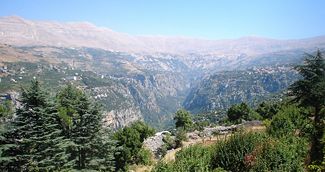
A combination of beautiful climate, many historic landmarks and World Heritage Sites continues to attract large numbers of tourists to Lebanon annually, in spite of its political instability. In addition, Lebanon's strict financial secrecy and capitalist economy—unique in its area—have given it significant economic status among Arab countries. The thriving tourism and banking activities have naturally made the services sector the most important pillar of the Lebanese economy. The majority of the Lebanese workforce (nearly 65%)[28] have preferred employment in the services sector, as a result of the abundant job opportunities and large paychecks. The GDP contribution, accordingly, is very large and amounts to roughly 67.3% of the annual Lebanese GDP.[29]
The economy's dependence on services has always been an issue of great criticism and concern, since this renders the country subject to the instability of this sector and the vagaries of international trade.
Historical development
The 1975-1990 civil war seriously damaged Lebanon's economic infrastructure, cut national output by half, and all but ended Lebanon's position as a Middle Eastern entrepôt and banking hub.[20] The subsequent period of relative peace enabled the central government to restore control in Beirut, begin collecting taxes, and regain access to key port and government facilities. Economic recovery has been helped by a financially sound banking system and resilient small- and medium-scale manufacturers, with family remittances, banking services, manufactured and farm exports, and international aid as the main sources of foreign exchange.[30]
Until the 2006 Lebanon War, Lebanon's economy witnessed excellent growth, with bank assets reaching over 75 billion dollars.[31] By the end of the first half of 2006, the influx of tourists to Lebanon has already registered a 49.3% increase over 2005 figures.[31] Market capitalization was also at an all time high, estimated at $10.9 billion at the end of the second quarter of 2006, just weeks before the fighting started.Cite error: Closing </ref> missing for <ref> tag
Beirut International airport re-opened in September 2006 and the efforts to revive the Lebanese economy have since been proceeding at a slow pace. Major contributors to the reconstruction of Lebanon include Saudi Arabia (with 1.5 billion US dollars pledged),[32] the European Union (with about $1 billion)[33] and a few other Gulf countries with contributions of up to $800 million.[34]
Education
Schools
All Lebanese schools are required by the government to follow a prescribed curriculum designed by the Ministry of Education. Private schools, approximately 1,400 in all,[35] may also add more courses to their curriculum with approval from the Ministry of Education. The main subjects taught are Mathematics, Sciences, History, Civics, Geography, Arabic, and French, English or both. Other rotating teachers within the school teach Physical Education, Art, and at times library use. The subjects gradually increase in difficulty and in number. Students in Grade 11, for example, usually study up to eighteen different subjects.
The government introduces a mild form of selectivity into the curriculum by giving 11th graders choice between two "concentrations": Sciences or Humanities, and 12th graders choice between four concentrations: Life Sciences (SV), General Sciences (SG), Sociology and Economics (SE), and Humanities and Literature (LH). The choices in concentration do not include major changes in the number of subjects taken (if at all). However, subjects that fall out of the concentration are given less weight in grading and are less rigorous, while subjects that fall within the concentration are more challenging and contribute significantly to the final grade.
Students go through three academic phases:
- Elementary : six years.
- Intermediate: three years; students earn Intermediate Certification (Lebanese Brevet) at completion.
- Secondary: three years, students who pass official exams earn a Baccalaureate Certificate (Baccalauréat Libanais) in the concentration they chose in 12th grade.
These three phases are provided free to all students and the first eight years are, by law, compulsory.[36] Nevertheless, this requirement currently falls short of being fully enforced.
Higher education
Following high school, Lebanese students may choose to study at a university, a college, or a vocational training institute. The number of years to complete each program varies.
While the Lebanese educational system offers a very high quality and international class of education, the local employment market lacks enough opportunities, thus encouraging many of the young educated to travel abroad. You can find successful Lebanese engineers, doctors, businessmen, etc. practically all over the world.
Lebanon has 41 nationally-accredited universities, several of which are internationally recognized.[37][38] The American University of Beirut (AUB) and the Université Saint-Joseph (USJ) were the first English and the first French universities to open in Lebanon respectively.[39][40] The forty-one universities, both public and private, largely operate in French, or English as these are the most widely used foreign languages in Lebanon.[41]
At the English universities, students who have graduated from an American-style high school program enter at the freshman level to earn their baccalaureate equivalence from the Lebanese Ministry of Higher Education. This qualifies them to continue studying at the higher levels. Such students are required to have already taken the SAT I and the SAT II upon applying to college, in lieu of the official exams. On the other hand, students who have graduated from a school that follows the Lebanese educational system are directly admitted to the sophomore year. These students are still required to take the SAT I, but not the SAT II.
Culture
Overview
The area including modern Lebanon has been for thousands of years a melting pot of various civilizations and cultures. Originally home to the Phoenicians, and then subsequently conquered and occupied by the Assyrians, the Persians, the Greeks, the Romans, the Arabs, the Ottoman Turks and most recently the French, Lebanese culture has over the millennia evolved by borrowing from all of these groups. Lebanon's diverse population, composed of different ethnic and religious groups, has further contributed to the country's lively festivals, highly successful musical styles and literature as well as their rich cuisine - and numerous violent clashes amongst different religious and ethnic groups. When compared to the rest of the Middle East, Lebanese society as a whole is well educated, and as of 2003 87.4% of the population was literate.[42] Lebanese society is very modern and similar to certain cultures of Mediterranean Europe. Not only is Lebanon a distinctive fusion of Christian and Muslim traditions unequaled in the rest of the region, it also serves as the European gateway to the Middle East as well as the Arab gateway to the Western World.[43]
Languages
Arabic is the official language of Lebanon.[44] French, too, is widely spoken and was an official language during the French mandate (which lasted until 1943). Spoken Lebanese is quite different from the standard written Arabic language which is taught in schools along with the other foreign languages. English has become very popular in recent years as well,[44] especially among university students, as a second or sometimes third language. Armenian is the native tongue of the Armenian Lebanese in Lebanon.[45]
Cuisine
The Lebanese cuisine combines the sophistication of European cuisines with the exotic ingredients of the Middle East.[46] Some of the most popular local dishes include Kibbeh—a lamb-and-cracked-wheat dish, often grilled or fried—and Tabbouleh, a salad made with cracked wheat, finely chopped parsley, tomato, onions and olive oil.[47] The Lebanese also enjoy eating food from many different regions;[47] fast food has also gained widespread popularity, especially among the Lebanese youth.
Arts and literature
In literature, Gibran Khalil Gibran is known to be one of the world's famous writers, particularly known for his book The Prophet, which has been translated into more than twenty different languages.[48]
In art, Moustapha Farroukh and Alfred Bassbouss are very famous. Charles Khoury is also a very known artist, and he has been awarded many national and international prizes.
Festivals
Several international festivals are held in Lebanon, featuring world-renowned artists and drawing crowds from Lebanon and abroad. Among the most famous are the summer festivals at Baalbek, Beiteddine, and Byblos. Beirut in particular has a very vibrant arts scene, with numerous performances, exhibits, fashion shows, and concerts held throughout the year in its galleries, museums, theatres, and public spaces.
Politics
Template:Politics of Lebanon
Lebanon is a parliamentary, democratic republic, which implements a special system known as confessionalism.[49] This system, meant to insure that sectarian conflict is kept at bay, attempts to fairly represent the demographic distribution of religious sects in the governing body. As such, high-ranking offices in the government are reserved for members of specific religious groups. The President, for example, has to be a Maronite Catholic Christian, the Prime Minister a Sunni Muslim, the Deputy Prime Minister an Orthodox Christian, and the Speaker of the Parliament a Shi’a Muslim.[50][51]
This trend continues in the distribution of the 128 parliamentary seats, which are divided in half between Muslims and Christians. Prior to 1990, the ratio stood at 6:5 in favor of Christians; however, the Taif Accord, which put an end to the 1975-1990 civil war, adjusted the ratio to grant equal representation to followers of the two religions.[50] According to the constitution, direct elections must be held for the parliament every four years, although for much of Lebanon’s recent history, civil war precluded the exercise of this right.
The parliament elects the president for a non-renewable six-year term. At the urging of the Syrian government, this constitutional rule has been bypassed by ad hoc amendment twice in recent history. Elias Hrawi’s term, which was due to end in 1995, was extended for three years.[52] This procedure, denounced by pro-democracy campaigners, was repeated in 2004 to allow Émile Lahoud to remain in office until 2007.[53]
The President appoints the Prime Minister on the nomination of the parliament (which is, in most cases, binding).[54] Following consultations with the parliament and the President, the Prime Minister forms the Cabinet, which must also adhere to the sectarian distribution set out by confessionalism.
Lebanon's judicial system is based on the Napoleonic Code. Juries are not used in trials. The Lebanese court system consists of three levels: courts of first instance, courts of appeal, and the court of cassation. There also is a system of religious courts having jurisdiction over personal status matters within their own communities, with rules on matters such as marriage, divorce, and inheritance. Lebanese law does not provide for Civil marriage (although it recognizes such marriages contracted abroad); efforts by former President Elias Hrawi to legalize civil marriage in the late 1990s floundered on objections mostly from Muslim clerics. Additionally, Lebanon has a system of military courts that also has jurisdiction over civilians for crimes of espionage, treason, and other crimes that are considered to be security-related.[55] These military courts have been criticized by human rights organizations such as Amnesty International for "seriously fall[ing] short of international standards for fair trial" and having "very wide jurisdiction over civilians".[56]
History
Ancient history
The earliest known settlements in Lebanon date back to earlier than 5000 B.C.E. Archaeologists have discovered in Byblos, which is considered to be the oldest continuously-inhabited city in the world, remnants of prehistoric huts with crushed limestone floors, primitive weapons, and burial jars which are evidence of the Neolithic and Chalcolithic fishing communities who lived on the shore of the Mediterranean Sea over 7,000 years ago.[4]
Lebanon was the homeland of the Phoenicians, a seafaring people that spread across the Mediterranean before the rise of Cyrus the Great.[57] After two centuries of Persian rule, Alexander the Great attacked and burned Tyre, the leading Phoenician city. Throughout the subsequent centuries leading up to recent times, the country became part of numerous succeeding empires, among them Persian, Greco-Macedonian, Roman, Byzantine, Arab, Crusader, and Ottoman.
French mandate and independence
| History of the Levant |
| Stone Age |
|---|
|
Kebaran · Natufian culture · |
| Ancient History |
|
Sumerians · Ebla · Akkadian Empire · |
| The Middle Ages |
|
Umayyad · Abassid |
| Modern Times |
Lebanon was part of the Ottoman Empire for over 400 years, in a region known as Greater Syria,[58] until 1916 when the area became a part of the French Mandate of Syria following World War I. On September 1, 1920, France formed the State of Greater Lebanon as one of several ethnic enclaves within Syria.[59] Lebanon was a largely Christian (mainly Maronite) enclave but also included areas containing many Muslims and Druzes. On September 1, 1926, France formed the Lebanese Republic. The Republic was afterward a separate entity from Syria but still administered under the French Mandate for Syria.
Lebanon gained independence in 1943, while France was occupied by Germany.[60] General Henri Dentz, the Vichy High Commissioner for Syria and Lebanon, played a major role in the independence of the nation. The Vichy authorities in 1941 allowed Germany to move aircraft and supplies through Syria to Iraq where they were used against British forces. The United Kingdom, fearing that Nazi Germany would gain full control of Lebanon and Syria by pressure on the weak Vichy government, sent its army into Syria and Lebanon.
After the fighting ended in Lebanon, General Charles de Gaulle visited the area. Under various political pressures from both inside and outside Lebanon, de Gaulle decided to recognize the independence of Lebanon. On 26 November 1941 General Georges Catroux announced that Lebanon would become independent under the authority of the Free French government. Elections were held in 1943 and on November 8, 1943 the new Lebanese government unilaterally abolished the mandate. The French reacted by throwing the new government into prison. In the face of international pressure, the French released the government officials on 22 November 1943 and accepted the independence of Lebanon.
The allies kept the region under control until the end of World War II. The last French troops withdrew in 1946. Lebanon's unwritten National Pact of 1943 required that its president be Christian and its prime minister be Muslim.
Lebanon's history since independence has been marked by alternating periods of political stability and turmoil (including a civil conflict in 1958) interspersed with prosperity built on Beirut's position as a regional center for finance and trade.
1948 Arab-Israeli war
Five years after gaining independence, Lebanon joined its fellow Arab states and invaded Israel.[61] during the 1948 Arab-Israeli War. It took over logistical support of the Arab Liberation Army after it found itself cut off from its bases in Syria while attempting an attack on the newly-proclaimed Jewish State.[61] After the defeat of the Arab Liberation Army in Operation Hiram,[62] Lebanon accepted an armistice with Israel on 23 March 1949. Approximately 100,000 Palestinian refugees were living in Lebanon in 1949 as a result of the creation of Israel and the subsequent war.[63] The Lebanese-Israeli border remained closed, but quiet, until after the Six Day War in 1967.
Civil war and beyond
In 1975, civil war broke out in Lebanon. The Lebanese Civil War lasted fifteen years, devastating the country's economy, and resulting in the massive loss of human life and property. It is estimated that 150,000 people were killed and another 200,000 maimed.[64] The war ended in 1990 with the signing of the Taif Agreement and parts of Lebanon were left in ruins.[65]
During the civil war, Lebanon was twice invaded and occupied by the Israel Defense Forces (IDF) in 1978 and 1982.[66] Israel remained in control of Southern Lebanon until 2000, when there was a general decision, led by Israeli Prime Minister Ehud Barak, to withdraw due to continuous guerrilla attacks executed by Hezbollah militants and a belief that Hezbollah activity would diminish and dissolve without the Israeli presence.[67] The UN determined that the withdrawal of Israeli troops beyond the blue line was in accordance with UN Security Council Resolution 425, although a border region called the Shebaa Farms is still disputed. Hezbollah declared that it would not stop its operations against Israel until this area was liberated.[68]
After the end of the civil war, Lebanon saw a period of relative calm until the 2006 Lebanon War.
Recent events
Cedar Revolution
Assassinations
On 14 February 2005 former Prime Minister Rafik Hariri was assassinated in a car bomb explosion.[69] Leaders of the March 14 Alliance accused Syria of the attack,[70] due to its extensive military and intelligence presence in Lebanon, and the public rift between Hariri and Damascus over the Syrian-backed constitutional amendment extending pro-Syrian President Lahoud's term in office. Syria denied any involvement.[70] Others, namely the Forces of March 8 and Syrian officials, claimed that the assassination may have been executed by the American CIA or the Israeli Mossad in an attempt to destabilize the country.[71]
The Hariri assassination marked the beginning of a series of assassination attempts that led to the loss of many prominent Lebanese figures. On June 3, 2005, the journalist and historian Samir Kassir, also a founding member of the Democratic Left Movement was assassinated by a car bomb.[72] Less than one month later, on June 21, 2005, George Hawi, the former Secretary General of the Lebanese Communist Party was also assassinated by a car bomb in Beirut.[73]
On September 25, 2005, there was a failed assassination attempt on a Lebanese Broadcasting Corporation news anchor, in which May Chidiac lost her left leg below the knee and received severe injuries to her left arm, later resulting in the amputation of her left hand.[74] She later won the UNESCO/Guillermo Cano World Press Freedom Prize in 2006.[75] Editor-in-chief and CEO of the An-Nahar newspaper, journalist Gebran Tueni, was assassinated by a car bomb in the suburbs of Beirut on December 12, 2005.[76]
Investigation and proposed UN tribunal
The United Nations Security Council unanimously adopted Resolution 1595 on April 7, 2005, which called for an investigation into the assassination of Rafik Hariri.[77] The findings of the investigation were officially published on 20 October, 2005 in the Mehlis report.[78] The report suggested the assassination was carried out by a group with considerable resources, that it had been prepared many months in advance, and that the group had detailed knowledge of Hariri’s movements.[79]
International forensic teams identified the vehicle used for the explosion as a Mitsubishi Canter stolen on 12 October, 2004 in Sagamihara, Japan.[80] They also concluded that the explosion was most likely detonated by a suicide bomber.[80] This investigation into the Hariri assassination is ongoing and has yet to be concluded. On 17 January, 2006 the UN appointed Serge Brammertz to continue the investigation;[81] the report from this investigation has yet to be published.
The United Nations Security Council and the Lebanese cabinet have approved a Special Tribunal for Lebanon that would prosecute those responsible for Hariri's death. As of 6 February, 2006, however, the Lebanese government has still not ratified the tribunal.[82]
Demonstrations
On 28 February 2005, with over 50,000 people demonstrating in Martyrs' Square, Prime Minister Omar Karami and his Cabinet resigned.[83] In response, Hezbollah organized a large counter-demonstration attended by hundreds of thousands of people,[84][85] which was staged on March 8 in Beirut, supporting Syria and accusing Israel and the United States of meddling in internal Lebanese affairs.
On March 14, 2005, one month after Hariri's assassination, throngs of people rallied in Martyrs' Square in Lebanon with around 1 million people.[84][86] Protesters marched demanding the truth about Hariri's murder and independence from Syrian presence in Lebanon. The march reiterated their desire for a sovereign, democratic, and unified country, free of Syria's hegemony.
In the weeks following the demonstrations, bombs were detonated in Christian areas near Beirut.[87] Although the damage was mostly material, these acts threatened to drag Lebanon back into sectarian strife.
Eventually, and under pressure from the international community, Syria began withdrawing its 15,000-strong army troops from Lebanon.[88] By April 26, 2005, all uniformed Syrian soldiers had already crossed the border back to Syria.[89] On April 27, 2005, the Lebanese celebrated their first free-from-Syria day. UN forces led by Senegalese Brig. Gen. Mouhamadou Kandji and Lebanese Brig. Gen. Imad Anka were sent to Lebanon to verify the military withdrawal which was mandated by UN Security Council Resolution 1559.[90]
Elections
During the first parliamentary elections held after Syria's withdrawal from Lebanon in May 2005, the anti-Syrian coalition of Sunni Muslim, Druze and Christian parties led by Saad Hariri, son of assassinated ex-Prime Minister Rafik Hariri, won a majority of seats in the new Parliament.[91] The Free Patriotic Movement (FPM), though not allied with the Rafik Hariri Martyr List during the elections, garnered strong representation in the newly elected Parliament.[92]
The political alliances were interesting in that in some areas the anti-Syrian coalition allied with Hezbollah and in others with Amal. They did not win the two-thirds majority required to force the resignation of Syrian-appointed President Lahoud voted for by Rafik Hariri parliamentary bloc, due to the unexpectedly strong showing of formerly exiled General Michel Aoun's Free Patriotic Movement party in Mount Lebanon. Despite being staunchly anti-Syrian during his 15-year exile, upon his return Aoun aligned himself with politicians who were friendly to the Syrians in the past decade: Soleiman Franjieh Jr and Michel Murr. Their alliance dominated the north and the Matn District of Mount Lebanon. Saad Hariri and Walid Jumblatt joined forces with the two staunchly pro-Syrian Shiite movements, Hezbollah and Amal, to secure major wins in the South, Beqaa, as well as the Baabda and Aley districts of Mount Lebanon. This alliance proved temporary. On 6 February 2006 Hezbollah signed an understanding of disarmament with Michel Aoun, the leader of the Free Patriotic Movement.
After the elections, Hariri's Future Movement party, now the country's dominant political force, nominated Fouad Siniora, a former Finance Minister, to be Prime Minister.[93] His newly formed representative government has obtained the vote of confidence from the parliament.
On July 18, 2005, Lebanon elected a new parliament dominated by an anti-Syrian coalition. This parliament approved a motion to free Samir Geagea, leader of the Christian Lebanese Forces,[94] who had spent most of the past eleven years in solitary confinement in an underground cell with no access to news.[95] The motion was endorsed by pro-Syrian Lebanese President Émile Lahoud the next day.[96]
2006 Lebanon War
On July 12, 2006, following an operation executed by Hezbollah militants on Israeli territory, Israel launched a massive military operation against the Lebanon-based Hezbollah. The fighting quickly escalated into 33 days of "open war" and ultimately led to the death of 1,191 Lebanese and 44 Israeli civilians.[97][98] Over the course of the war 4,409 were injured in Lebanon and nearly a million were displaced.[98]
Fighting came to end on August 14, three days after UN Security Council Resolution 1701—which called for an immediate cessation of hostilities—was passed.[99] Israel, however, maintained a naval and aerial blockade on Lebanon in a measure meant to prevent Hezbollah from smuggling arms.[100] The blockade was lifted on September 8, and by early December, all Israeli troops had withdrawn from Lebanon.[101][102]
See also
| Lebanon Portal |
- Cities and villages in Lebanon
- Communications in Lebanon
- Military of Lebanon
- Shebaa Farms
- South Lebanon conflict
- Transport in Lebanon
- List of Lebanese Banks
- List of Lebanese people
- List of Lebanon-related topics
- List of universities in Lebanon
- Gay rights in Lebanon
References and footnotes
- ↑ Countries Quest. "Lebanon, Government". Retrieved December 14, 2006.
- ↑ U.S. Department of State. "Background Note: Lebanon (History) August 2005" Retrieved December 2, 2006.
- ↑ USPG. "Anglican Church in Jerusalem responds to the Middle East crisis". Retrieved October 31, 2006.
- ↑ Socialist Party (2005). "A new crisis in the Middle East?". Retrieved October 31, 2006.
- ↑ 5.0 5.1 Anna Johnson (2006). "Lebanon: Tourism Depends on Stability". Retrieved October 31, 2006.
- ↑ TC Online (2002). "Paris of the Middle East". Retrieved October 31, 2006.
- ↑ Canadian International Development Agency. "Lebanon: Country Profile". Retrieved December 2, 2006.
- ↑ Center for the Study of the Built Environment. "Deconstructing Beirut's Reconstruction: 1990-2000". Retrieved October 31, 2006.
- ↑ Joumana Medlej. "The Mountain". Retrieved December 15, 2006.
- ↑ 10.0 10.1 Antoine Harb (2004). "Lebanon: A Name through 4000 Years". Retrieved November 1, 2006.
- ↑ Christian World News. "Lebanon Historically Linked to the Bible". Retrieved February 21, 2007.
- ↑ Roger Yazbeck. "Lebanon was mentioned 71 times in the Holy Bible...". Retrieved February 21, 2007.
- ↑ Telegraph (2000). "Israel's Withdrawal from Lebanon Given UN's Endorsement". Retrieved November 1, 2006.
- ↑ Encyclopædia Britannica. "Lebanon". Retrieved December 10, 2006.
- ↑ (Bonechi et al.) (2004) Golden Book Lebanon, p. 3, Florence, Italy: Casa Editrice Bonechi. ISBN 88-476-1489-9
- ↑ Country Studies US. "Lebanon - Climate". Retrieved November 5, 2006.
- ↑ 17.0 17.1 Blue Planet Biomes. "Lebanon Cedar - Cedrus libani". Retrieved December 10, 2006.
- ↑ USAID Lebanon. "USAID Lebanon—Definitions of Terms used". Retrieved December 17, 2006.
- ↑ Country Studies. "Lebanon Population". Retrieved November 25, 2006.
- ↑ 20.0 20.1 20.2 CIA, the World Factbook (2006). "Lebanon". Retrieved November 7, 2006.
- ↑ International Journal of Kurdish Studies, Jan, 2002 by Lokman I. Meho "The Kurds in Lebanon: a social and historical overview"
- ↑ Marina Sarruf (2006). "Brazil Has More Lebanese than Lebanon". Retrieved November 30, 2006.
- ↑ UNRWA (December 31, 2003). "UNRWA: Palestinian Refugees". Retrieved November 25, 2006.
- ↑ U.S. Department of State (1994) Header: People, 4th paragraph. Retrieved December 3, 2006.
- ↑ Background Note: Lebanon "www.washingtoninstitute.org" Retrieved December 3, 2006.
- ↑ United Nations Population Fund."Lebanon - Overview". Retrieved November 9, 2006.
- ↑ Federal Research Division of the Library of Congress, U.S.A. 1986-1988. [1]. Retrieved December 2, 2006.
- ↑ 28.0 28.1 28.2 Jean Hayek et al, 1999. The Structure, Properties, and Main Foundations of the Lebanese Economy. In The Scientific Series in Geography, Grade 11, 110-114. Beirut: Dar Habib.
- ↑ 29.0 29.1 29.2 US Department of State (2005). "Lebanon". Retrieved November 1, 2006.
- ↑ CIA World Factbook 2001. Retrieved 2006-12-04.
- ↑ 31.0 31.1 Bank Audi (2006). "Lebanon Economic Report: 2nd Quarter, 2006". Retrieved November 27, 2005.
- ↑ Cyprus News (2006). "Saudi Arabia Key Contributor To Lebanon's Reconstruction". Retrieved November 26, 2006.
- ↑ Lebanon Under Siege (2006). "Donors pledge more than $940 million for Lebanon". Retrieved November 26, 2006.
- ↑ Ain-Al-Yaqeen (2006). "The Custodian of the Two Holy Mosques Reviews with the Jordanian King the Situation in Lebanon...". Retrieved November 27, 2006.
- ↑ Samidoun (2006). "Aid groups scramble to fix buildings, fill backpacks before school bell rings". Retrieved December 9, 2006.
- ↑ US Department of State (2005). "Lebanon". Retrieved December 15, 2006.
- ↑ Infopro Management. "Lebanon Opportunities - Business Information". Retrieved January 30, 2007.
- ↑ (Arabic)Lebanese Directory of Higher Education. "Decrees". Retrieved January 30, 2007.
- ↑ eIFL.net Regional Workshop (2005). "Country Report: Lebanon". Retrieved December 14, 2006.
- ↑ Université Saint-Joseph. "125 years of history - A timeline". Retrieved December 8, 2006.
- ↑ Yalla!. "Yalla! Students". Retrieved December 15, 2006.
- ↑ Lebanon CIA World Fact Book. [2]. December 18, 2006.
- ↑ Lebanon Culture. [3]. December 18, 2006.
- ↑ 44.0 44.1 Country Studies. "Lebanon - Languages". December 6, 2006.
- ↑ Arda Arsenian – Ekmekji. "Revisiting Artin in Beirut: How Armenians Are Viewed in Lebanon". Retrieved January 26, 2007.
- ↑ Joe George. "Lebanon: The Jewel of the Middle East". Retrieved December 3, 2006.
- ↑ 47.0 47.1 Microsoft Encarta Premium 2006. Customs of Lebanon.
- ↑ The Hindu (January 5, 2003). "Called by life";. Retrieved January 8, 2007.
- ↑ Bureau of Democracy, Human Rights, and Labor (2002). "Country Reports on Human Rights Practices - 2002: Lebanon". Retrieved January 3, 2007.
- ↑ 50.0 50.1 United States Institute of Peace (March 2006). "Lebanon's Confessionalism: Problems and Prospects". Retrieved January 3, 2007.
- ↑ Marie-Joëlle Zahar. "CHAPTER 9 POWER SHARING IN LEBANON: FOREIGN PROTECTORS, DOMESTIC PEACE, AND DEMOCRATIC FAILURE1". (DOC) Retrieved January 3, 2007.
- ↑ Middle East Intelligence Bulletin (2004). "The US and France Tip the Scale in Lebanon's Power Struggle". Retrieved January 6, 2007.
- ↑ New Age International (November 6, 2006). "Lebanon leaders head for talks amid street protest threats". Retrieved January 3, 2007.
- ↑ Lebanon2000.com. "Factbook - Lebanon". Retrieved January 3, 2006.
- ↑ US Department of State (2006). "Country Reports on Human Rights Practices, 2005: Lebanon". Retrieved December 17, 2006.
- ↑ Amnesty International (2005). "A Human Rights Agenda for the Parliamentary Elections, Lebanon". Retrieved December 17, 2006.
- ↑ About.com (1987)."Lebanon in Ancient Times". Retrieved December 17, 2006.
- ↑ U.S. Library of Congress. "History: Present-Day Syria". Retrieved May 2, 2007.
- ↑ Chorbishop Seely Beggiani (2005). "Aspects of Maronite History (Part Eleven) The twentieth century in the Middle East". Retrieved January 24, 2007.
- ↑ Lebanese Global Information Center. "History of Lebanon". Retrieved December 9, 2006.
- ↑ 61.0 61.1 Karsh, Efraim (2002). The Arab-Israeli Conflict. The Palestine War 1948. Osprey Publishing. ISBN 1841763721, p. 27
- ↑ Avi Shlaim. "Israel and the Arab Coalition in 1948". Retrieved December 9, 2006.
- ↑ Amnesty International. "Palestinian refugees in Lebanon". Retrieved November 14, 2006.
- ↑ Time (1991). "After the War, the Mop-Up". Retrieved November 30, 2006.
- ↑ Council on Foreign Relations (2006). "The Future of Lebanon". Retrieved December 18, 2006.
- ↑ People's Daily (2000). "Lebanese Troops Patrol Near Fatma Gate Along Border With Israel". Retrieved December 18, 2006.
- ↑ Israel Ministry of Foreign Affairs (2000)."Withdrawal from Lebanon: Press Briefing by Foreign Minister David Levy". Retrieved November 1, 2006.
- ↑ The key to Shebaa, Al-Jazeera online, retrieved April 1, 2007.
- ↑ Hariri.info (2005). "Rafik Hariri". Retrieved December 10, 2006.
- ↑ 70.0 70.1 CBC News Indepth (2006). "Recent background on Syria's presence in Lebanon". Retrieved December 10, 2006.
- ↑ See this MEMRI bulletin, includes several statements and sources.
- ↑ UNESCO-CI. "Samir Kassir". Retrieved December 10, 2006.
- ↑ Nur al-Cubicle (2005). "Biography of George Hawi (Georges Haoui)". Retrieved December 10, 2006.
- ↑ BBC News. "Timeline: Lebanon explosions". Retrieved December 10, 2006.
- ↑ The Arab Press Network (2006). "May Chidiac Wins UNESCO Press Freedom Award". Retrieved December 10, 2006.
- ↑ The Daily Star (2005). "Gibran Tueni assassinated by car bomb". Retrieved December 10, 2006.
- ↑ "United Nations Security Council Resolution 1595 (2005)".
- ↑ United Nations Security Council (2005). "Letter dated 20 October 2005 from the Secretary-General addressed to the President of the Security Council". Retrieved November 2, 2006.
- ↑ Al Bab (2005). "The Mehlis report, 2005: full text". Retrieved December 10, 2006.
- ↑ 80.0 80.1 Consortiumnews.com (2005). "The Dangerously Incomplete Hariri Report". Retrieved December 11, 2006.
- ↑ FPS Foreign Affairs (2006). "Serge Brammertz appointed head of the UN International Independent Investigation Commission". Retrieved December 11, 2006.
- ↑ Hariri murder tribunal awaits approval after UN and Lebanon sign deal
- ↑ CNN (2005). "Lebanon's pro-Syrian PM resigns". Retrieved December 11, 2006.
- ↑ 84.0 84.1 A great deal of controversy surrounds the exact numbers of the participants in the March 2005 demonstrations; reported numbers thus vary widely by source.
- ↑ The Washington Post (2005). "Syria Supporters Rally in Lebanon". Retrieved December 11, 2006.
- ↑ FOX News (2005). "Up to One Million Lebanese Protesters Mark Hariri Killing". Retrieved November 2, 2006.
- ↑ BBC News (2005). "Bomb hits Beirut's Christian area". Retrieved December 11, 2006.
- ↑ BBC News (2005). "Syria begins Lebanon withdrawal". Retrieved December 11, 2006.
- ↑ CNN (2005). "Last Syrian troops leave Lebanon". Retrieved December 11, 2006.
- ↑ Guardian Unlimited (2005). "Ceremony marks departure of last Syrian troops". Retrieved December 11, 2006.
- ↑ The Jerusalem Post (2005). "Opposition sweeps Lebanon's elections". Retrieved December 12, 2006.
- ↑ International Herald Tribune (2005). "Aoun scores upset win in Lebanese elections". Retrieved December 12, 2006.
- ↑ BBC News (2005). "Profile: Fouad Siniora". Retrieved December 21, 2006.
- ↑ BBC News. "Lebanese ex-warlord is released". Retrieved December 21, 2006.
- ↑ MSNBC (July 26, 2005). "Lebanon ex-warlord freed after 11 years". Retrieved December 21, 2006.
- ↑ Iran Daily (2005). "Geagea Free". Retrieved December 21, 2006.
- ↑ "Israel, Hezbollah Vow Wider War", The Washington Post.
- ↑ 98.0 98.1 Humanitarian Assistance to Lebanon. United States Agency for International Development Disaster Assistance (November 3 2006). Retrieved 2006-11-18.
- ↑ CNN (2006). "Lebanon truce holds despite clashes". Retrieved December 7, 2006.
- ↑ New York Times (September 9, 2006). "Israel Ends Its Blockade of Lebanon’s Coastline". Retrieved January 25, 2007.
- ↑ Cite error: Invalid
<ref>tag; no text was provided for refs namedblocakde - ↑ Reuters (December 3, 2006). "Israel to quit Lebanon border village -officials". Retrieved December 3, 2006.
- Fisk, Robert. Pity the Nation: The Abduction of Lebanon. New York: Nation Books, 2002.
- Holst, Sanford. Phoenicians: Lebanon's Epic Heritage. Los Angeles: Cambridge and Boston Press, 2005.
- Norton, Augustus R. Amal and the Shi'a: Struggle for the Soul of Lebanon. Austin and London: University of Texas Press, 1987.
- Riley-Smith, Jonathan. The Oxford Illustrated History of the Crusades. New York: Oxford University Press, 2001.
- Salibi, Kamal. A House of Many Mansions: The History of Lebanon Reconsidered. Berkeley: University of California Press, 1990.
- Abe F. March: author of To Beirut and Back - An American in the Middle East (ISBN 1-4241-3853-1) recounts the years shortly before and including the beginning of the Lebanese Civil War (1975-1990). He is also listed as an Expert on Israeli-Palestinian ProCon.org
External links
- Web portals
- Government
- The Lebanese Governmental Portal for Information & Forms
- Official site of the President of the Lebanese Republic
- Official site of The Lebanese Parliament (Arabic)(French)
- Central Administration for Statistics
- Ministry of Tourism
- Internal Security Forces
- The Lebanese Armed Forces
- General-security.gov.lb
- Lebanon Customs site
- Central Bank of Lebanon
- Beirut Stock Exchange
- Embassy of Lebanon, Washington, D.C.
- News
- AnNahar newspaper (Arabic)
- As-Safir newspaper (Arabic)
- Al-Akhbar newspaper (Arabic)
- L'Orient-Le Jour (Lebanese daily newspaper in French) (French)
- LBC
- Future TV
- United Nations - Mehlis Report official report of the investigation into Rafiq al-Hariri's assassination
- Ya Libnan - Lebanon News, Videos and Photos (Lebanese daily news in English) (English)
- Culture and education
- UNESCO World Heritage Sites in Lebanon
- Al-Bustan Festival, Beit Meri
- Baalbek Festival
- Beiteddine Festival
- Byblos Festival
- Lebanese Cultural Journal
- The National Museum of Beirut
- General information
- Lebanon at the The World Factbook
- US State Department - Lebanon includes Background Notes, Country Study and major reports
- LibanVote (comprehensive electoral database)
- Groups and associations
- Festivals
- Travel and Tourism
- Ministry of Tourism - Official website of the Lebanese Ministry of Tourism
- Travel to Lebanon - Online travel guide to Lebanon
Credits
New World Encyclopedia writers and editors rewrote and completed the Wikipedia article in accordance with New World Encyclopedia standards. This article abides by terms of the Creative Commons CC-by-sa 3.0 License (CC-by-sa), which may be used and disseminated with proper attribution. Credit is due under the terms of this license that can reference both the New World Encyclopedia contributors and the selfless volunteer contributors of the Wikimedia Foundation. To cite this article click here for a list of acceptable citing formats.The history of earlier contributions by wikipedians is accessible to researchers here:
The history of this article since it was imported to New World Encyclopedia:
Note: Some restrictions may apply to use of individual images which are separately licensed.


